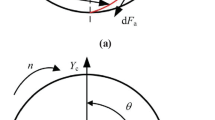Abstract
This paper proposes the elaboration model of energy requirement prediction taking into account the power of standby, spindle rotation in non-load, feeding, and rapid movement in X, Y, Z+, and Z− axially, and specific energy consumption (SEC) in the X and Y cutting directions, respectively, which could not be considered complete in other models. Each part energy of specific machine tools could be obtained through little experiments for identifying the relationship between energy and tool path with cutting parameters. The method is validated by 27 trial cutting experiment in X and Y cutting directions in the VMC850E machine; the results show that the SEC in the X and Y cutting directions is different. Moreover, it is found that spindle power should be piecewise linear representation according to spindle speed characteristic, due to the correlation coefficient of power model only has 25.45% without segmented. Additionally, the correlation coefficient of the improved SEC model could reach more than 99.98% in each segment. The contribution of this paper is mainly the elaboration energy consumption model considering the cutting direction, which is an efficient approach for predicting energy consumption through tool path to achieve sustainable production in manufacturing sectors.









Similar content being viewed by others
Data availability
All the data have been presented in the manuscript.
References
Zhou L, Li J, Li F, Meng Q, Li J, Xu X (2016) Energy consumption model and energy efficiency of machine tools: a comprehensive literature review. J Clean Prod 112:3721–3734
Zhao GY, Liu ZY, He Y, Cao HJ, Guo YB (2017) Energy consumption in machining: classification, prediction, and reduction strategy. Energy 133:142–157
Gutowski T, Dahmus J, Thiriez A (2006) Electrical energy requirements for manufacturing processes. In: 13th CIRP international conference on life cycle engineering, Leuven, Belgium, May 31st-June 2nd, pp 560–564
Diaz N, Redelsheimer E, Dornfeld D (2011) Energy consumption characterization and reduction strategies for milling machine tool use. In: Hesselbach J, Herrmann C (eds) Glocalized Solutions for Sustainability in Manufacturing. Springer, Berlin Heidelberg, pp 263–267
Kara S, Li W (2011) Unit process energy consumption models for material removal processes. CIRP Ann Manuf Technol 60(1):37–40
Li L, Yan J, Xing Z (2013) Energy requirements evaluation of milling machines based on thermal equilibrium and empirical modeling. J Clean Prod 52:113–121
Newman ST, Nassehi A, Imani-Asrai R, Dhokia V (2012) Energy efficient process planning for CNC machining. CIRP J Manuf Sci Technol 5(2):127–136
Balogun VA, Mativenga PT (2013) Modelling of direct energy requirements in mechanical machining processes. J Clean Prod 41:179–186
Mori M, Fujishima M, Inamasu Y, Oda Y (2011) A study on energy efficiency improvement for machine tools. CIRP Ann Manuf Technol 60(1):145–148
Balogun VA, Aramcharoen A, Mativenga PT, Chuan SK (2013) Impact of machine tools on the direct energy and associated carbon emissions for a standardized NC toolpath. In: 20th CIRP International Conference on Life Cycle Engineering, Singapore, April 17–19, pp 197–202
He Y, Liu F, Wu T, Zhong FP, Peng B (2012) Analysis and estimation of energy consumption for numerical control machining. Proc Inst Mech Eng B J Eng Manuf 226(2):255–266
Behrendt T, Zein A, Min S (2012) Development of an energy consumption monitoring procedure for machine tools. CIRP Ann Manuf Technol 61(1):43–46
Altnta RS, Kahya M, Zgür H (2016) Modelling and optimization of energy consumption for feature based milling. Int J Adv Manuf Technol 86:3345–3363
Moradnazhad M, Unver HO (2017) Energy consumption characteristics of turn-mill machining. Int J Adv Manuf Technol 91:1991–2016
Hu L, Tang R, Cai W, Feng Y, Ma X (2019) Optimisation of cutting parameters for improving energy efficiency in machining process. Robot Comput Integr Manuf 59:406–416
Shin SJ, Woo J, Rachuri S (2017) Energy efficiency of milling machining: component modeling and online optimization of cutting parameters. J Clean Prod 161:12–29
Chen X, Li C, Tang Y, Xiao Q (2018) An internet of things based energy efficiency monitoring and management system for machining workshop. J Clean Prod 199:957–968
He Y, Wu P, Li Y, Wang Y, Wang Y (2020) A generic energy prediction model of machine tools using deep learning algorithms. Appl Energy 275:115402
Xu L, Huang C, Li C, Wang J, Liu H, Wang X (2020) A novel intelligent reasoning system to estimate energy consumption and optimize cutting parameters toward sustainable machining. J Clean Prod 261:121160
Edem IF, Balogun VA, Nkanang BD, Mativenga PT (2019) Software analyses of optimum toolpath strategies from computer numerical control (CNC) codes. Int J Adv Manuf Technol 103:997–1007
Moreira LC, Li WD, Lu X, Fitzpatrick ME (2019) Sustainable machining process: qualitative analysis and energy efficiency optimization. In: Li W, Wang S (eds) Sustainable Manufacturing and Remanufacturing Management- Process Planning, Optimization and Applications. Coventry, UK, pp 165–189
Akkuş H, Yaka H (2021) Experimental and statistical investigation of the effect of cutting parameters on surface roughness, vibration and energy consumption in machining of titanium 6Al-4V ELI (grade 5) alloy. Measurement 167:108465
Acknowledgements
Shi Huang, Guozhen Bai, Yilong Wu, and Haohao Guo are thanked for providing technical support during the experiments.
Funding
This research is funded by the National Natural Science Foundation of China Grant No. 51605294
Author information
Authors and Affiliations
Contributions
Chunhua Feng: conceptualization, methodology, software, validation, writing-original draft, funding acquisition. Xiang Chen: investigation, data curation, software. Jingyang Zhang: investigation, data curation, resources. Yugui Huang: investigation, data curation, resources.
Corresponding author
Ethics declarations
Ethical approval
Not applicable.
Consent to participate
The authors declare that they all consent to participate this research.
Consent to publish
The authors declare that they all consent to publish the manuscript.
Competing interests
The authors declare no competing interests.
Additional information
Publisher’s note
Springer Nature remains neutral with regard to jurisdictional claims in published maps and institutional affiliations.
Rights and permissions
About this article
Cite this article
Feng, C., Chen, X., Zhang, J. et al. A generalized analysis of energy saving strategies through experiment for CNC milling machine tools. Int J Adv Manuf Technol 117, 751–763 (2021). https://doi.org/10.1007/s00170-021-07787-9
Received:
Accepted:
Published:
Issue Date:
DOI: https://doi.org/10.1007/s00170-021-07787-9




